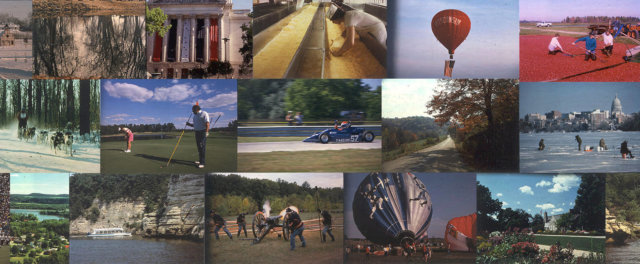Wisconsin History
“Thirty thousand voices rose in one deafening cheer, and universal joy seemed to pervade the face of every man present.” – from the new book, “General Joseph Bailey – Hero of the Red River”. The cheering was heard at Alexandria, Louisiana in the spring of 1864, when the first Union gunboat trapped above the rapids of the Red River passed down the chute of the newly-constructed dam.
The dam saved the most powerful battle fleet ever assembled in the Mississippi Valley, spared the failed Union advance up the Red from suffering another disastrous defeat, and brought national fame and honor to its creator.
This is the story of the man, the places and the events that made Joseph Bailey the hero of the Red River. Click here for information about this book.
Wisconsin was first inhabited by varied Indian tribes in the 17th century. They included the Algonquian-speaking Menominee, Kickapoo, Miami, the Siouan-speaking Winnebago, Dakota (or Sioux) and Iowa. In the mid-1600’s other groups entered Wisconsin, including the Fox, Sac, Potawatomi and Ojibewa (Chippewa).
Jean Nicolet, a native of France, was the first explorer to reach the area while searching for the Northwest Passage to China in 1634. The French lost possession of Wisconsin and all of it’s territories east of the Mississippi to Great Britain during the French and Indian War.
British possession of Wisconsin ended in 1783, when Britain signed the treaty ending the American Revolution. Because the U.S. government had no effective control over Wisconsin, it remained under unofficial British control. Fur trade continued as the foundation of Wisconsin’s economy.
The first wave of American settlers in Wisconsin came in the 1820’s as a result of a lead mining boom in northwest Illinois and southwest Wisconsin. The movement of white settlers into the Midwest caused intense conflict when the federal government and settlers attempted to move Native Americans from their lands. Federal policies included uprooting entire tribes and forcing them to resettle west of the Mississippi. When the Sac people tried to return in 1832, the Black Hawk War started ending in the Bad Axe Massacre with less than 1000 Native Americans surviving. Other Wisconsin tribes either left the area, or negotiated reservation lands.
No longer having opposition from the Native Americans, a second wave of settlers came to Wisconsin and in 1836 the Wisconsin Territory was organized. Around the 1840’s a third wave of settlers came to Wisconsin, attracted by good farmland. At that time the state became the nation’s leading wheat producer. On May 29, 1848, Wisconsin was admitted to the Union as the 30th state.
The State Historical Society of Wisconsin
State Symbols
| Flag Coat of Arms Seal Motto Animal Beverage Bird Dance Dog Domesticated Animal Fish |
Flower Fossil Grain Insect Mineral Rock Soil Song Symbol of Peace Tree Wildlife Animal |
Wisconsin State Flag
Adopted: 1863
An official design for Wisconsin’s state flag was initially provided by the legislature in 1863. Until that date, a flag had not been adopted and Civil war regiments in the field were requesting flags. The legislature formed a 5 member joint select committee to report “a description for a proper state flag.” This action resulted in the adoption of Wisconsin’s flag. In 1913, the flag was changed, specifying a dark blue background with the state coat of arms centered at each side. That design remained unchanged until 1979, when legislature was asked to change the flag design so it would appear more distinctive and recognizable. They added the word “Wisconsin” and the statehood date in “1848” in white letters, centered respectively above and below the coat of arms.
Coat of Arms
Starting at the top is the state motto “Forward”. Below is a badger that represents the state animal. A sailor and miner show that the people work on water and land. The shield in the center shows Wisconsin’s support for the United States. In four sections surrounding the shield are representations of Wisconsin’s main industries: Agriculture, mining, manufacturing and navigation. The cornucopia and pile of lead represent farm products and minerals.
State Seal
Adopted: 1851
The state seal consists of the coat of arms with the words “Great Seal of The State of Wisconsin” centered above a curved line of 13 stars representing the 13 original United States centered below and surrounded by an ornamental border.
State Motto: “Forward”
Adopted: 1851
In 1851, Governor Dewey had asked UW Chancellor John Lathrop to design a new state seal. It is alleged that the motto was selected during a chance meeting between Governor Dewey and Edward Ryan when the governor went to New York City to have the new seal engraved. Ryan objected to the Latin motto “Excelsior”, which Lathrop proposed. According to tradition, Dewey and Ryan sat on the steps of a Wall Street bank and designed a new seal, choosing “Forward” as the motto.
| Return to Top of Page | Return to Symbol List |
State Animal: Badger
Adopted: June 20, 1957
The first European immigrants to arrive in Wisconsin found it desirable for the natural resources it offered. They began mining lead and galena to be used in shot for guns and paint. Miners who wanted to work through the winter found that the most useful shelters were their excavations. They added makeshift roofs or walls to complete them. Since these miners dig for their livelihoods and live in “burrows,” they nicknamed them badgers. The term was later applied to all new settlers in the mining area and eventually to all who lived in Wisconsin.
State Beverage: Milk
Adopted: 1987
Milk was adopted as the state beverage because Wisconsin is the leading milk-producing state and because of its contribution to the states economy.
State Bird: American Robin
Adopted: June 4, 1949
The robin was elected the state bird by a youth committee set up in 1948 for Wisconsin’s Centennial. The children thought the robin was most fitting because it brought glad tidings of spring and the re-awakening of Nature’s beauties after a cold winter.
| Return to Top of Page | Return to Symbol List |
State Dance: “Polka”
Adopted: 1993
The state dance was recommended by a group of second graders in Madison and was supported by several other groups. It was chosen for the polka heritage in Wisconsin and its cultural value.
State Dog: American Water Spaniel
Adopted: 1985
The American water spaniel was chosen as the state dog because it is one of only five dog breeds native to the United States and the only one native to Wisconsin.
State Domesticated Animal: Dairy Cow
Adopted: 1971
The dairy cow was adopted as Wisconsin’s official domesticated animal because of it’s great contributions to the state. This made sense since “America’s Dairyland” is seen on our license plates. As part of the adoption the state was required to establish an annual rotation among Wisconsin’s purebred cows.
State Fish: Muskellunge (Musky)
Adopted: March 30, 1955
The musky was recommended as the state fish because of the dominance of Wisconsin muskies in competition over the years. The trout was also suggested but failed to pass because it wasn’t nearly as popular as the musky.
| Return to Top of Page | Return to Symbol List |
State Flower: Wood Violet
Adopted: June 4, 1949
Wisconsin’s school children were asked to vote for an official state flower in 1908, which left four finalists: arbutus, violet, white water lily and wild rose. The following year they voted again using the four finalists and the violet won. However, the violet was only named Wisconsin’s unofficial state flower until 1948. Finally, during the Centennial celebration, a youth committee was set up to officially adopt several state symbols. At this time the official flower, tree and bird were decided.
State Fossil: Trilobite Calymene Celebra
Adopted: April 2, 1986
The trilobite was said to be the best suited for the state fossil because no other fossil had been the subject of so much attention in Wisconsin by both amateur and professional alike.
State Grain: Corn
Adopted: 1989
Corn was chosen as the states official grain because sponsors claimed designating corn would draw attention to the importance of corn as a cash crop and make people more aware of its many uses.
State Insect: Honey Bee
Adopted: 1977
The honey bee was adopted as the official state insect by the request of a third grade class in Marinette and by Wisconsin Honey Producers Association. Wisconsin produced around 3.6 million pounds of honey in 2011.
State Mineral: Galena (lead)
Adopted: March 9, 1971
The Kenosha Gem and Mineral Society, to promote geological awareness, introduced the proposal for Wisconsin to adopt a mineral. Galena was chosen because of its immense role in Wisconsin’s history and economy. After all Galena (lead) was what first attracted European settlers to Wisconsin.
State Rock: Red Granite
Adopted: March 9, 1971
As with the state mineral, red granite was chosen after the Kenosha Gem and Mineral Society proposed a mineral and rock be chosen to promote geological awareness. Red granite was chosen because of its abundance, uniqueness, economic value, historical significance and because it is indigenous to our state.
State Soil: Antigo Silt Loam
Adopted: September 14, 1983
Professor Francis D. Hole chose the state soil because “…it is scattered through a dozen or so counties from east to west, and is versatile.”
| Return to Top of Page | Return to Symbol List |
State Song: “On Wisconsin”
| “On Wisconsin!”
Written by J. S. Hubbard and Charles D. RosaComposed by William T. Purdy “On Wisconsin! On Wisconsin! |
Adopted: 1959
“On Wisconsin” was written in 1909 by William T. Purdy, but the original lyrics were changed by J. S. Hubbard and Charles D. Rosa in 1913. This was done to commemorate the centennial of the Battle of Lake Erie. Although “On Wisconsin” was widely recognized as the state song, it wasn’t officially adopted until 1959. At that time they had discovered that several different lyrics existed so an official text for the first verse was incorporated.
State Symbol of Peace: Mourning Dove
Adopted: November 16, 1971
The mourning dove was adopted as the state symbol of peace by individuals and organizations concerned with conservation and wildlife.
State Tree: Sugar Maple
Adopted: June 4, 1949
The sugar maple was elected as the state tree by a committee of school children during the Centennial celebration in 1948, along with the state bird and flower. It was also won during a vote in 1893, but was never officially elected.
State Wildlife Animal: White-tailed Deer
Adopted: 1957.
In 1957, people campaigned for the adoption of the badger as the state animal, but residents of northern Wisconsin disagreed. Therefore they introduced a legislation to adopt the white-tailed deer. They noted that the white-tailed deer was abundant in northern Wisconsin, were large and attractive and had reat economic value. At that time the legislature decided to use both as state animals, and the white-tailed deer became the state wildlife animal while the badger became the state animal.







